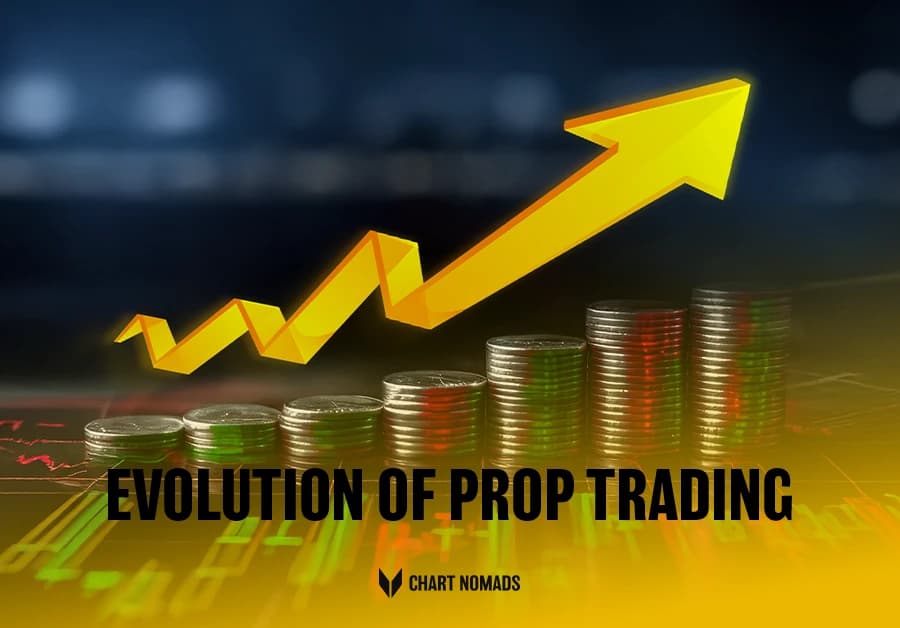The Evolution of Prop Trading: Trends to Watch in 2025
Prop trading, short for proprietary trading, has long been the domain of firms leveraging their own capital to earn profits. For traders, it represents a unique career path full of opportunities to capitalize on market movements without risking personal funds. Over the years, prop trading has transformed significantly, driven by changing technologies, market dynamics, and trader expectations.
As we look toward 2025, the prop trading industry is set to shift further, propelled by advancements in artificial intelligence, regulatory developments, and globalization. Whether you're a professional trader, a financial analyst, or an aspiring day trader, understanding these trends can help you stay ahead in this competitive landscape.
The Rise of Retail Prop Trading
Imagine a world where everyday retail investors can access the same advantages as elite trading firms. That future might already be here. The rise of retail prop trading is perhaps one of the most significant trends reshaping the industry.
What’s Driving the Growth?
Advanced trading platforms and reduced commission rates are making prop trading more accessible to retail traders. Innovations in technology, such as user-friendly apps, have democratized the industry, creating a bridge between professional firms and everyday traders.
Why It Matters
Retail prop trading fosters a more inclusive environment, encouraging diverse participation. Platforms like Topstep and FTMO have introduced evaluation challenges that allow aspiring traders to prove their skills and gain access to funded accounts.
Takeaway: The trend toward accessible prop trading will likely continue, encouraging innovation in trader recruitment and platform development.
Automation and AI in Prop Trading
If there’s one technology shaping the future of prop trading, it’s artificial intelligence. Automation and AI are altering everything from decision-making processes to trade execution.
Predictive Analytics
AI algorithms analyze vast datasets to identify patterns, enabling more informed trading decisions. Tools like Kershner Trading Group’s AI capabilities allow firms to stay competitive.
Faster Execution
Trade automation provides speed, allowing traders to execute positions in milliseconds—a critical edge in today’s fast-moving markets.
Case Studies
Firms leveraging AI, such as Jane Street, report consistently higher profitability by integrating machine learning into their trading strategies.
Takeaway: Traders who adopt AI-driven strategies are likely to remain competitive as markets grow increasingly automated.
Regulatory Changes and Their Impact
The regulatory landscape surrounding prop trading continues to evolve, and 2025 will be no exception. Stricter guidelines aim to ensure fairness while protecting traders from fraudulent firms.
New Regulations
Frameworks like the European Union’s MiFID II and Dodd-Frank in the U.S. emphasize transparency and reporting.
Challenges
Compliance can create higher operational costs for firms, but it also weeds out illegitimate operators, ensuring a safer environment for traders.
Opportunities
Increased credibility in the industry will foster trust among traders and investors.
Takeaway: Keeping pace with regulatory changes is essential for both traders and firms aspiring to remain competitive.
Globalization of Prop Trading
Global markets present an exciting opportunity for prop traders to explore international assets and cross-border strategies.
Expanded Presence
Prop firms are opening offices in emerging markets, making it possible to trade a more diverse range of regional securities.
Challenges
Entering new markets often involves navigating unfamiliar regulations, cultural differences, and economic volatility.
Opportunities
Firms expanding globally position themselves to capitalize on untapped markets, which are often less saturated and more profitable.
Takeaway: For firms, global expansion opens doors. Traders should capitalize on opportunities in international markets to gain an edge.
The Future of Prop Trading: Predictions and Analysis
What lies ahead for prop trading in the next decade? Several expert predictions paint a picture of the future:
-
Greater Integration with Blockchain
Blockchain technology could provide a more transparent, decentralized trading environment. From recording transactions to facilitating cross-border trades, the potential is immense. -
Further Diversification of Asset Classes
The rise of cryptocurrencies, carbon credits, and even NFTs could become standard portfolios for prop traders. -
Gamification of Trading Initiatives
To attract younger, tech-savvy audiences, firms may explore gamification further. Features like leaderboards, rewards, and challenges could redefine the recruitment and onboarding experience. -
Enhanced Education and Mentorship
Firms will likely invest in trader education, offering live webinars, personalized coaching, and access to broader learning resources to upskill their teams.
Takeaway: Adaptability will be the key to thriving in the next generation of prop trading. Firms and traders must stay open to new opportunities while honing their skills.
Capitalizing on the Trends in Prop Trading
The evolution of prop trading is steering it in exciting directions, and those willing to adapt will reap the rewards. We’re seeing retail prop trading rise, AI transform decision-making, globalization bring new opportunities, and regulations foster transparency. The 2025 horizon is brimming with potential for traders and firms alike.
For traders, staying informed and nimble is crucial. For firms, the focus should be on adopting advanced tools and building a strong foundation that aligns with broader trends.
What are your thoughts on these trends? Which do you think will shape the industry the most? Share your insights and join the discussion—we’d love to hear from you.


